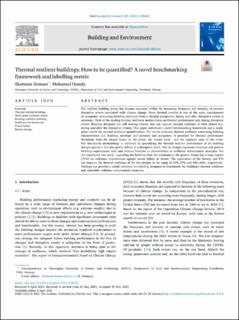| dc.contributor.author | Homaei, Shabnam | |
| dc.contributor.author | Hamdy, Mohamed | |
| dc.date.accessioned | 2022-03-04T08:45:42Z | |
| dc.date.available | 2022-03-04T08:45:42Z | |
| dc.date.created | 2021-06-07T12:55:15Z | |
| dc.date.issued | 2021 | |
| dc.identifier.citation | Building and Environment. 2021, 201 . | en_US |
| dc.identifier.issn | 0360-1323 | |
| dc.identifier.uri | https://hdl.handle.net/11250/2982996 | |
| dc.description.abstract | The resilient building design has become necessary within the increasing frequency and intensity of extreme disruptive events associated with climate change. Since thermal comfort is one of the main requirements of occupants, evaluating building resilience from a thermal perspective during and after disruptive events is necessary. Most of the existing thermal resilience metrics focus on thermal performance only during disruptive events. Building designers are still seeking metrics that can capture thermal resilience in both phases (i.e. during and after the disruptive events). This paper introduces a novel benchmarking framework and a multi-phase metric for thermal resilience quantification. The metric evaluates thermal resilience concerning building characteristics (i.e. building envelope and systems) and occupancy. It penalises for thermal performance deviations from the targets based on the phase, the hazard level , and the exposure time of the event. The introduced methodology is validated by quantifying the thermal resilient performance of six building designs against a four-day power failure as a disruptive event. The six designs represent minimum and passive building requirements with and without batteries or photovoltaics as resilience enhancement strategies. For the considered case study, upgrading the building from the minimum to the passive design has a huge impact (71%) on resilience improvement against power failure in winter. The application of the battery and PVs can improve the thermal resilience of the two designs in the range of 19%–27% and 44%–60%, respectively. Findings can provide a useful reference for building designers to benchmark the building’s thermal resilience and constitute resilience enhancement measures. | en_US |
| dc.language.iso | eng | en_US |
| dc.publisher | Elsevier | en_US |
| dc.rights | Navngivelse 4.0 Internasjonal | * |
| dc.rights.uri | http://creativecommons.org/licenses/by/4.0/deed.no | * |
| dc.title | Thermal resilient buildings: How to be quantified? A novel benchmarking framework and labelling metric | en_US |
| dc.type | Peer reviewed | en_US |
| dc.type | Journal article | en_US |
| dc.description.version | publishedVersion | en_US |
| dc.source.pagenumber | 14 | en_US |
| dc.source.volume | 201 | en_US |
| dc.source.journal | Building and Environment | en_US |
| dc.identifier.doi | 10.1016/j.buildenv.2021.108022 | |
| dc.identifier.cristin | 1914172 | |
| dc.relation.project | Norges forskningsråd: 257660 | en_US |
| cristin.ispublished | true | |
| cristin.fulltext | original | |
| cristin.qualitycode | 2 | |

